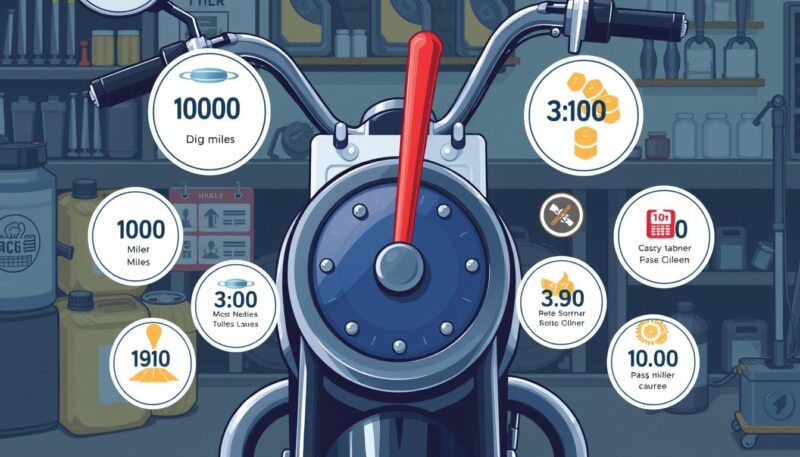Maintaining your motorcycle is essential for keeping it in peak condition, and one of the most critical aspects of this maintenance is the regular motorcycle oil change. Understanding how often to change motorcycle oil can greatly affect your bike’s performance and longevity. Whether you ride a sportbike, cruiser, or touring motorcycle, the benefits of regular oil changes cannot be overstated. Failing to change your oil on time can lead to engine inefficiencies, increased wear and tear, and often, costly repairs that could have been avoided. In this article, you’ll discover not only how frequently you should perform an oil change, but also the types of oil available, and crucial maintenance tips to ensure your motorcycle runs smoothly.
Understanding Motorcycle Oil and Its Importance
Motorcycle oil plays a pivotal role in maintaining the efficiency and longevity of your engine. Understanding motorcycle oil importance can significantly enhance your motorcycle’s performance. Proper lubrication allows the moving parts of the engine to function smoothly, reducing wear and preventing overheating. Regular monitoring and changing of oil contribute to a cleaner engine, ensuring optimal performance.
Why Motorcycle Oil Matters
Choosing the right oil for your motorcycle is vital. Natural mineral oils are ideal for smaller engines that operate with minimal mechanical pressure. In contrast, fully synthetic oils are best suited for high-performance motorcycles, such as superbikes and racing bikes. Semi-synthetic oils serve motorcycles with engine capacities of 250cc or above.
The formulation process of motorcycle oils differs from that of car oils due to variations in stress levels and technological requirements. Understanding these differences allows you to make informed decisions for your motorcycle engine oil care, ensuring you choose the right product to fit your needs.
What Does It Mean to Change Your Motor Oil?
Motor oil change meaning encompasses more than just replacing the old oil with new. It involves draining the dirty oil that accumulates debris and contaminants over time and inserting fresh oil to maintain engine efficiency. The oil grading system, such as 10W40, indicates the viscosity of the oil at various temperatures, helping in choosing the right oil for specific conditions.
Regular oil changes are essential for preventing wear and damage inside the engine. Such preventive maintenance maintains smooth operation and power output. The first oil replacement is generally recommended after 1,000 kilometers, followed by subsequent changes every 12,000 kilometers. Ignoring these intervals can lead to decreased fuel economy, shorter engine life, and increased wear on engine parts.
| Oil Type | Recommended For | Performance Characteristics |
|---|---|---|
| Natural Mineral Oil | Smaller engines | Low mechanical pressure, basic lubrication |
| Semi-Synthetic Oil | Engines 250cc and above | Enhanced performance, better heat resistance |
| Fully Synthetic Oil | High-performance motorcycles | Optimal performance, excellent protection, high temperatures |
How Often Should You Change Your Motorcycle Oil?
The timing for oil change in motorcycles greatly influences engine performance and longevity. Regular maintenance ensures that your motorcycle runs smoothly, so understanding the factors affecting oil change is essential. These factors include the type of oil used, your riding habits, and environmental conditions. Here, we outline essential considerations for determining the right frequency for oil changes.
Factors Influencing Oil Change Frequency
Several factors play a crucial role in deciding when your motorcycle oil requires changing. These include:
- Type of motorcycle oil (mineral, semi-synthetic, or synthetic)
- Your riding style and frequency of use
- Environmental conditions such as heat or dusty environments
- Age and condition of the motorcycle
Taking these elements into account can help maintain optimal performance and ensure you adhere to the recommended oil change intervals.
Recommended Change Intervals Based on Oil Type
Understanding recommended oil change intervals based on the type of oil is vital for your motorcycle’s health. The following table outlines the intervals for different oil types:
| Oil Type | Recommended Mileage |
|---|---|
| Mineral Oil | Every 2,000 – 3,000 miles |
| Semi-Synthetic Oil | Every 5,000 – 6,000 miles |
| Synthetic Oil | Every 7,000 – 10,000 miles |
Regular changes are especially important for infrequently ridden motorcycles. In such cases, aiming for at least twice a year is advisable. For frequent riders and high-mileage motorcycles, more regular changes may be necessary regardless of the oil type used. Proper timing for oil change in motorcycles not only enhances engine health but also prevents costly repairs down the line.

Motorcycle Oil Change: Tips for Maintaining Your Engine
Understanding how to maintain your motorcycle oil is essential for its longevity and performance. Recognizing the signs of oil change needed can prevent serious engine damage and save you from costly repairs. Here are some effective motorcycle oil change tips and steps on how to change motorcycle oil correctly.
Signs Your Motorcycle Oil Needs Changing
- Low dipstick reading
- Excess vibrations during operation
- Loud engine noises while running
- Unusually high engine temperature
If you observe any of these symptoms, it’s a clear indication that it’s time for an oil change. Ignoring these signs can lead to a reduced lifespan of your engine.
How to Change Your Motorcycle Oil
Changing your motorcycle oil can be straightforward if you follow step-by-step instructions. Begin by gathering the necessary materials:
- Motorcycle-specific oil (JASO MA/MA2 certified)
- New oil filter
- Drain pan
- Tools required as per your manual
Before starting, ensure the engine is cool and take a 10-minute ride to heat the oil for effective draining. Follow these steps:
- Remove any parts needed to access the drain and filler plugs.
- Drain the old oil for about 5-10 minutes until the stream reduces to a trickle.
- Replace the drain plug gasket with a new one if applicable.
- Tighten the drain plug using a box or socket wrench, ensuring not to overtighten.
- Install the new oil filter, applying a small amount of oil on the gasket for a proper seal.
- Refer to your owner’s manual to add the correct amount of new oil.
- Run the engine and check the oil level using the sight glass or dipstick.
Lastly, proper disposal of used oil and filters is crucial to help protect the environment. Local dumps or auto parts stores often accept used oil for recycling.

Conclusion
Understanding how often to change your motorcycle oil is crucial for optimal motorcycle maintenance. Regular oil changes not only protect your engine from potential damage but also enhance your motorcycle’s overall performance. You will notice better acceleration, smoother shifting, and increased power, contributing to a more enjoyable riding experience.
Moreover, the importance of oil changes extends to improving fuel efficiency by reducing engine workload, which saves you money at the pump. Clean oil plays a key role in prolonging the life of your engine by safeguarding its components against premature wear. By being attentive to the condition of your oil and performing periodic changes, you will ensure that your motorcycle remains in peak condition.
Prioritizing your oil change routine should be part of your motorcycle care tips, allowing you to enjoy the road with confidence. Be mindful of the recommended intervals for oil changes and watch for signs that indicate it’s time to switch out your oil. With consistent care, you will keep your motorcycle performing at its best for years to come.






